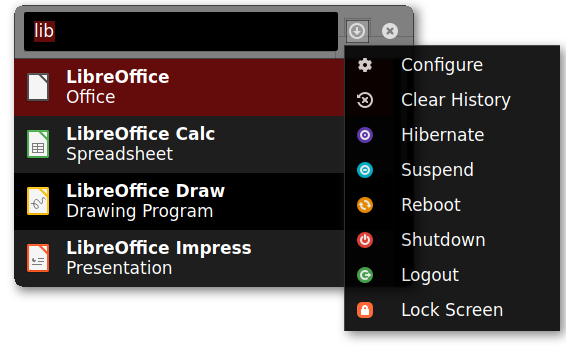lxqt-runner provides a GUI that comes up on the desktop and allows for launching applications or shutting down the system. A calculator function is implemented too.
Technically it consists of a single binary lxqt-runner. The binary is run in a daemon-like manner as so-called LXQt Module and brings up the GUI when a configured keyboard shortcut is hit.
Runtime dependencies are lxqt-globalkeys, muparser, KWindowSystem, layer-shell-qt and optionally menu-cache.
Additional build dependencies are CMake and optionally Git to pull latest VCS checkouts.
Code configuration is handled by CMake. CMake variable CMAKE_INSTALL_PREFIX has to be set to /usr on most operating systems.
To build run make, to install make install which accepts variable DESTDIR as usual.
Official binary packages are provided by all major Linux and BSD distributions. Just use your package manager to search for string lxqt-runner.
Launching binary lxqt-runner as LXQt Module can be adjusted from section "Basic Settings" in configuration dialogue "LXQt Session Settings" (binary lxqt-config-session) of lxqt-session.
The keyboard shortcut to launch the GUI can be configured either in "Configure" in the lxqt-runner menu or in "Global Actions Manager" (binary lxqt-config-globalkeyshortcuts) of lxqt-globalkeys.
Note: As lxqt-globalkeysd is not yet supported on Wayland, a keyboard shortcut for lxqt-runner should be added in the compositor settings.
In the configuration dialogue it's also possible to customize settings like the position where it's displayed, how many items to show and whether to use and save a history.
To launch an application corresponding strings need to be filed in the form, next a selection can be made from a list presenting matches. Items to shut down or restart the system and so on are provided by the menu featuring the configuration dialogue as well.
Translations can be done in LXQt-Weblate

